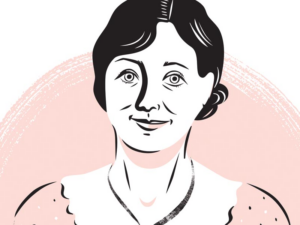Marion Frances Blood
By Pamela VanderPloeg
Life Dates: b. March 30 1900, d. March 1 1990
Full Name: Marion Frances Blood
Birthplace: Grand Rapids, MI
Tags: Arts, Military, Women’s Clubs
Who would have guessed that a talented woman architect who was designing homes in 1925 Grand Rapids would be drafting plans for war munitions in 1942 and the Mackinac Bridge in 1952?
After Marion Blood graduated from Grand Rapids Central High School in 1918, she went to work as a draftswoman for architect Kenneth Welch, who encouraged her to apply to the University of Michigan’s architecture program. She was one of three women and 25 men to graduate in 1924 with a B.S. in Architecture and became a member of the T-square Architecture Honor Society. Her talent and initiative won Blood the coveted University of Michigan Booth Graduate Fellowship for six months of European travel, during which she studied Paris buildings and English landscape architecture.
The 1920s building boom provided unprecedented opportunities for women in architecture. In 1925 when Blood returned from Europe, she designed upscale homes for Grand Rapids architect Alexander McColl who, following his University of Michigan graduation, had trained as a young draftsman in the Detroit office of Emily Butterfield, Michigan’s first registered woman architect. Blood also became a registered architect by examination in 1932; but when the Depression caused McColl to close his downtown office, she found various work projects, including teaching women home building skills at the YWCA’s Caroline Putnam School.
In 1942, the Wartime Procurement Act converted U.S. manufacturing into wartime industries creating more opportunities for women. Blood, who was working for General Motors, became a Civil Service assistant architectural engineer designing defense guns and tools for the Grand Rapids office of the Chicago-based Air Force Central Technical Training Command. Blood moved to Muskegon in 1943. Completing a Michigan State University Time and Motion Studies certificate, she worked as a process engineer on glider contracts for the Brunswick-Balke-Collender Company and also designed homes and building additions on the side.
In 1947, Blood moved to Ohio where she and her sister had inherited a large family farm in historic Washington Township, Columbiana County. Blood worked in Youngstown for Glancy & Carle as a structural draftsman, and from 1949-1952 taught architectural, structural and mechanical drafting to veterans.
In 1952, Blood became an engineering detailer on the Mackinac Bridge project for the American Bridge Company Division of the U.S. Steel Company in Pittsburgh. Detailers were required to complete over 89,000 blueprints and structural drawings. She continued to work on other important bridge contracts until her retirement, including the Hudson River’s Tappan Zee Bridge (replaced in 2017). Blood’s degree and experience made her eligible to join the Society of Women Engineers, formed in 1950 to promote women in engineering. Based on employer recommendations, the organization later granted her senior engineer status.
Blood did not slow down during retirement. She engaged in nonstop volunteer work, including serving as the Salem, Ohio Historical Society president. She died at age 89 in 1990 and is buried in the Ohio’s Highlandtown Cemetery.
Marion Blood’s life and work of 47 years in West Michigan and 42 years in Ohio stand as a model of persistent professional courage and determination. Extraordinarily, during the 1920s and 1930s Grand Rapids had two other talented women architects, in addition to Marion Blood. From 1909 to 1930 the self-trained Fannie Boylon designed over 1,200 homes in partnership with her husband. After his death in 1930 Boylon retired, leaving a legacy of Dutch Colonial-, English- and Four-Square-style homes in the central city, Eastown and East Grand Rapids. Then Myrtle Louise Gilleo, after college and working for Alexander McColl, became lead architect for Blakeslee Brothers about 1925. Gilleo’s designs, similar to her Colonial- and English-style homes in Ottawa Hills, Midtown, and East Grand Rapids, were published in the Ladies Home Journal in 1929 and 1932.
Sources
This biography can also be found in the December 2019 issue of the Grand Rapids Women’s LifeStyle Magazine.

